Rice cake
This article needs additional citations for verification. (September 2012) |
A rice cake may be any kind of food item made from rice that has been shaped, condensed, or otherwise combined into a single object that has also been sweetened. A wide variety of rice cakes exist in many different cultures in which rice is eaten, and are particularly prevalent in Asia. Common variations include cakes made with rice flour, those made from ground rice, and those made from whole grains of rice compressed together or combined with some other binding substance.
Types of rice cakes by region
Types of rice cake include:
In Chinese cuisine
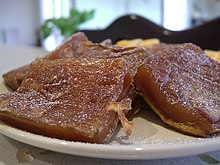
- Nian gao includes many varieties, all made from glutinous rice that is pounded or ground into a paste and, depending on the variety, may simply be molded into shape or cooked again to settle the ingredient.
- Tangyuan is made by mixing glutinous rice flour with a small amount of water to form balls and is then cooked and served in boiling water.
- Erkuai literally means "ear piece", a reference to the shape of one of its common forms.
- 江米糕 literally "river rice cake"
In Taiwanese cuisine
- Tainan bowl rice cake has its origins in the southern Taiwanese city Tainan. The dish is made by steaming glutinous rice once, then putting toppings in it and steaming it again.
In Korean cuisine

Steamed rice cake in an earthenware steamer was the oldest principal food for Koreans before sticky rice took over upon the invention of the iron pot.[1] Now, there are hundreds of different kinds of Korean rice cake or "tteok" eaten year round. In Korea, it is customary to eat tteok guk (tteok soup) on New Year's Day and sweet tteok at weddings and on birthdays. It is often considered a celebratory food and can range from rather elaborate versions or down to the plain-flavored tteok. Rice cakes are chosen for particular occasions depending on their color and the role they play in Korea’s traditional yin-yang cosmology.[2]
- Tteok is a class of Korean cakes mostly made with glutinous rice flour (also known as sweet rice or chapssal). Tteok is usually divided into four categories: "Steamed tteok" (찌는 떡, 甑餠), "Pounded tteok" (치는 떡, 搗餠), "Boiled tteok" (삶는 떡 搗餠) and "Pan-fried tteok" (지지는 떡 油煎餠).
- Sirutteok is one kind of steamed tteok that are rice (맵쌀, maepssal in Korean) or glutinous rice (찹쌀 chapssal) and sometimes they are mixed together with (but not limited to) other grains, beans (azuki beans or mung beans), sesame seeds, wheat flour, or starch can be mixed with the rice. Fruits and nuts are used as subsidiary ingredients.
- Injeolmi is an example of pounded tteok. The traditional preparation for pounded tteok is made by pounding rice or glutinous rice with utensils called jeolgu and jeolgutgongi or tteokme and anban. Injeolmi (tteok coated with bean powder), garaetteok (가래떡 cylinder-shaped white tteok), jeolpyeon (절편 patterned tteok) and danja (단자 glutinous tteok ball coated with bean paste)” are commonly eaten pounded tteok.
- Songpyeon and Bupyeon are rice cakes which have been molded into shape. There are dozens of these kinds of cakes in Korea, some can consist of doughs of glutinous rice flour and a sweet filling and covered with gomul, kind of powdered beans.[3] Ggul tteok (꿀떡) - literally means "tteok with honey" but the tteok is stuffed with Korean syrup. Ggul tteok is similar to songpyeon in shape, but smaller in size.
- Hwajeon[4] - small sweet pancakes made of flour of glutinous rice, and flower petals of Korean azalea, chrysanthemum, or rose.
- Tteokbokki is another dish apart from tteok guk that is made with tteok. It is a (usually) spicy dish commonly sold by street vendors, made with garaetteok.
- Tteokguk is a dish that is eaten in Seollal. It is like a soup. Ingredients are sliced Ddeok, anchovy, eggs and so on. Ddeokkuck is symbol of aging.
In Japanese cuisine

- Mochi is made of glutinous rice pounded into paste and molded into shape. In Japan it is traditionally made in a ceremony called mochitsuki. While also eaten year-round, mochi is a traditional food for the Japanese New Year and is commonly sold and eaten during that time. Mochi is also a prominent snack in Hawaii, Taiwan, Cambodia, and Thailand.
- Senbei are a type of Japanese rice crackers, usually cooked by being baked or grilled, traditionally over charcoal. While being prepared they may be brushed with a flavoring sauce, often one made of soy sauce and mirin. They may then be wrapped with a layer of nori. Alternatively they may be flavored with salt or so-called "salad" flavoring.
In Cambodian cuisine
Cambodian rice cake is somewhat different than other countries rice cake because unlike the other countries rice cake that are made with steamed rice, Cambodian's make theirs with sticky rice.
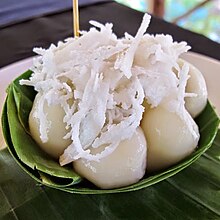
- Num Om Saum is a banana leaf sticky rice cake. It is served all year long but it is most prevalent during Bun Pchum Ben or "Ancestors' Day" festival. It is served either with a banana filling or pork fat strips and beans then they are wrapped with layers of banana leaf and steamed to perfection and then served.[5]
- Num Kom is steamed sweet sticky rice flour cake filled with palm sugar, freshly grated coconut and roasted sesame seeds.It is traditionally made and eaten on Memorial day for ancestors (Bun Pchum ben/Don-ta), Visak( Buddha birthday) and especially Cambodian New Year(Bon chol thnam tmey). It takes the shape of a pyramid to represent Buddhist pagoda towers.[6][7]
- Num Krok is sticky rice cake that is mixture of rice flour, coconut milk, chopped shallots and a little salt, dipped in fish and chili sauce and sometimes palm sugar.It is made with an iron pan.[8][9]
- Num Plae Ai(ផ្លែអាយ) is sticky rice balls with palm sugar on the inside and rolled in fresh coconut for a beautiful cover.[10][11][12]
- Num Ah-Kor (នំអាកោរ) is one of the most popular Cambodian/Khmer dessert. It is a dessert that is served during khmer new year and festivities. It is made with rice flour and topped with fresh shaved coconut. It comes in many colors.[13]
- Nom Chak-Kachan also known as sticky rice layer cake. It is made with sticky rice, tapioca flours, and coconut milk. It comes in a number of colors with green and yellow layers being the most popular.[14][15]
In Indian cuisines


- Patoleo are sweet rice cakes steamed in turmeric leaves consisting of a filling of coconut and palm jaggery. These are prepared by the Konkani people during their festivities.[16]
- Pitha, in the Bengali, Assamese and Oriya cuisines, is usually a thin-flat cake prepared from a batter made with soaked and ground rice. They are usually cooked on a hot griddle or frying pan and could be fried in oil, roasted over a slow fire or baked and rolled over a hot plate once made. In West Bengal and Bangladesh, special pithas are made in different processes such as steaming or stuffing, the bhapa and puli pithas being examples respectively. Special festivals where pithas are generally made include Nabanna in Bengali culture, Bihu in Assam and many festivals in East India.
- Idli in South Indian cuisine. The cakes are usually two to three inches in diameter and are made by steaming a batter, which is fermented overnight, consisting of black lentils (de-husked), and rice approximately 1:2 ratio with a bit of salt. Usually eaten with coconut chutney or sambhar - a type of lentil soup flavoured with tamarind.
- Puttu in South Indian cuisine, consists of firm cylinders of steamed ground rice with layers of coconut.
In Indonesian cuisine
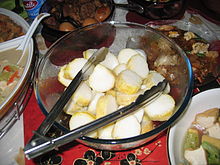
As a food staple
In Indonesia rice cakes can be plain and bland tasting, and are often treated as a food staple, as an alternative to steamed rice.
- Burasa, a type of rice dumpling cooked with coconut milk packed inside a banana leaf pouch. It is a delicacy of the Bugis and Makassar people of South Sulawesi, Indonesia, and often consumed as a staple to replace steamed rice or ketupat. It is similar to lontong, but with richer flavour acquired from coconut milk.
- Ketupat, or packed rice is a type of rice dumpling of Indonesia. Also can be found in Brunei, Malaysia, the Philippines, and Singapore. It is made from rice that has been wrapped in a Rhombus or kite shaped woven palm leaf pouch and boiled. As the rice cooks, the grains expand to fill the pouch and the rice becomes compressed. This method of cooking gives the ketupat its characteristic form and texture of a rice dumpling. Ketupat is usually eaten with rendang or served as an accompaniment to satay or gado-gado. Ketupat is also traditionally served by Malays at open houses on festive occasions such as Idul Fitri (Hari Raya Aidilfitri). During Idul Fitri in Indonesia, ketupat is often served with opor ayam (chicken in coconut milk), accompanied with spicy soy powder.
- Lontong, popular in Indonesia and also can be found in Malaysia, is made of compressed rice that is then cut into small cakes. It is traditionally made by boiling the rice until it is partially cooked and packing it tightly into a rolled-up banana leaf. The leaf is secured and cooked in boiling water for about 90 minutes. Once the compacted rice has cooled, it can be cut up into bite-sized pieces. The dish is usually served cold or at room temperature with sauce-based dishes such as gado-gado and salads, although it can be eaten as an accompaniment to other dishes such as Satay and curries.
- Nasi himpit, can be found in Indonesia and Malaysia. Unlike ketupat or lontong, nasi himpit is not cooked in a wrapping. Instead, the already boiled or steamed rice is pounded in a mortar into paste which is then molded and cut into a cube before eating. It's often eaten with Sayur lodeh or Soto.
As a snack
Numerous of Indonesian kue (traditional cake) are using glutinous rice or rice flour. It can be sweet or savoury.
- Arem-arem, a smaller lontong filled with vegetables and meat.
- Klepon, balls of glutinous rice flour filled with gula jawa (red coconut sugar), boiled or steamed. The balls are rolled upon grated coconut as the coconut granules stuck upon the balls. It is called "onde-onde" in Sumatra and Malay Peninsula
- Putu, green pandan colored rice flour filled with coconut sugar and steamed in bamboo cylinder.
- Kue lapis, layered colorful cake made of glutinous rice flour, coconut and sugar.
- Lemper, a savoury snack made of glutinous rice filled with chicken, fish or abon (meat floss). The meat filling is rolled inside the rice, in a fashion similar to an egg roll.
- Lepet, sticky rice dumpling mixed with peanuts cooked with coconut milk packed inside janur (young coconut leaf or palm leaf). It is a delicacy commonly found in Javanese and Sundanese cuisine of Java, Indonesia, and often consumed as snack.
- Lupis, compressed glutinous rice served with grated coconut and coconut sugar syrup.
- Nagasari or kue pisang, traditional steamed cake made from rice flour, coconut milk and sugar, filled with slices of banana.
- Serabi, traditional Indonesian pancake that is made from rice flour with coconut milk or just plain shredded coconut as an emulsifier.
- Semar mendem, variants of lemper, instead wrapped with banana leaf, the glutinous rice filled with chicken, fish or meat floss is wrapped inside thin egg omelette.
In Filipino cuisine


A common snack in the country, Filipinos have created many different kinds of rice cakes. In local language, it is called kakanin, derived from the word kanin, meaning prepared rice.
- Bibingka is a type of rice cake made with rice flour and coconut milk or water, with its bottom lined with banana leaves. It is traditionally baked using specially made clay ovens and preheated charcoal.
- Espasol is made from rice flour cooked in coconut milk and sweetened coconut strips, dusted with toasted rice flour.
- Kutsinta is a steamed rice cake made with rice flour, brown sugar, lye, and freshly grated mature coconut meat.
- Palitaw is a boiled rice cake disk covered with freshly grated mature coconut meat and sugar.
- Puto, derived from Indian cuisine puttu, is a steamed rice cake popular all over the country. It can be eaten alone as a snack, typically flavored with cheese, butter or butter substitute, or freshly grated mature coconut meat. It is also an accompaniment to a number of savory dishes, and as dessert in gatherings and festivities.
- Sapin-sapin is made from glutinous rice flour, coconut milk, sugar, water, and coconut flakes sprinkled on top. Its distinguishing layered appearance is achieved by using food coloring.
- Suman is made from glutinous rice cooked in coconut milk, and often steamed in banana leaves.
In Sri Lankan cuisine
- Idli, originating in South India, it is a savoury rice cake that is popularly eaten for breakfast.
- Puttu, originating in South India, it is widely consumed throughout the country. It is a cylinder made out of steamed ground rice and coconut.
- Seenakku, a rice cake made out of glutinous rice and served with grated coconut, it derives from the Chinese nian gao.
In Vietnamese cuisine
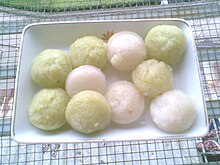
- Bánh bèo is a variety of small steamed rice cake or rice pancake typically featuring a dimple in the center, which is filled with savory ingredients including chopped dried or fresh shrimp, scallions, mung bean paste, crispy fried shallots, fish sauce, rice vinegar, and oil.
- Bánh bò is a sweet, chewy sponge cake made from rice flour, water, sugar, and yeast.
- Bánh đúc is a cake made from non-glutinous rice flour (although corn flour is also used in northern Vietnam). In the north it is typically garnished with savory ingredients such as ground pork, tôm chấy (grilled ground shrimp), fried onions, sesame seeds, salt, peanuts, lime juice, and soy sauce or fish sauce. In the south, it is served as a dessert, and takes the form of gelatinous blocks that are often colored green by the addition of Pandanus amaryllifolius leaf extract. It is cooked by boiling the ingredients and allowing them to cool, solidifying into a jelly-like sheetphoto that is then cut into blocks.
- Bánh chưng is made from glutinous rice, mung bean, pork and other ingredients. Bánh tét is much the same but cut in a circular form, and consumed in celebration of the Vietnamese holiday Tết.
- Bánh tổ is a rice cake made out of glutinous rice and is related to the Chinese nian gao.
In other cuisines
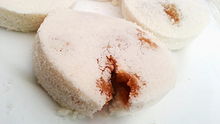
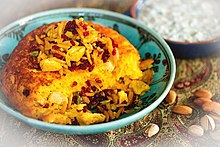
- Chwee kueh, (literally "water rice cake") is a type of steamed rice cake, a cuisine of Singapore and Johor. It is made by mixing rice flour and water to form a slightly viscous mixture, which is then placed in small cup-shaped containers that look like saucers and steamed, forming a characteristic bowl-like shape when cooked. The rice cakes are topped with diced preserved radish and served with chilli sauce. Chwee kueh is a popular breakfast item in Singapore and Johor.
- Puffed rice cakes, popular in North America and other Western countries, are made with puffed rice, a puffed grain usually created by heating rice kernels under high pressure in the presence of steam, though the method of manufacture varies widely. The puffed grains are then bonded together by a wide variety of methods in the form of a cake. They are popular among young children and among dieters as a lower calorie substitute for bread, crackers, or chips. They are often apple or honey flavored.
- Rijsttaart and Rijstevlaai in Dutch and Belgian cuisine are kinds of rice pie, with the filling of mixed rice, sugar, eggs and milk.
- In Italian cuisine, specifically the cuisine of Tuscany, torte di riso are rice cakes sometimes eaten as a substantial dessert at the end of a meal.
- In Iranian cuisine, Tahchin or Persian baked rice cake is a type of steamed rice cake made with yogurt, saffron, eggs, and chicken fillets.
See also
References
- ^ ko:떡
- ^ "Official Site of Korea Tourism Org.: `Rice Cake, Tteok :The Official Korea Tourism Guide Site". Retrieved 11 November 2012.
- ^ "경남도민일보 ::: 밀양떡, 양반 입맛 사로잡던 그 맛 그대로". Odomin.com. Retrieved 2012-09-03.
- ^ "No title". Lifeinkorea.com. Retrieved 2012-09-03.
- ^ Thompson, Nathan A. "Cambodian Ghosts Love Sticky Rice Cakes". Vice. Retrieved 23 September 2017.
- ^ "Eat and Nham PP". weebly. Retrieved 23 September 2017.
- ^ "Num Kom-Sticky Rice Cakes with coconut filling/Khmer Kozhukkattai!". Dosaikal.com. Retrieved 23 September 2017.
{{cite web}}:|first1=missing|last1=(help) - ^ Srey, Nit. "Deep in Thought in Philosopher's Lane". Khmer Times. Retrieved 23 September 2017.
- ^ "AUTHENTIC CAMBODIAN – BAIH KHMER". Junction Magazine. Retrieved 23 September 2017.
- ^ Sak, Chan Nita. "Eat and Nham PP". Weebly. Retrieved 23 September 2017.
- ^ "Khmer Memories – Num Plae Ai/Sticky Rice Sweet Balls". Dosaikal.com. Retrieved 23 September 2017.
{{cite web}}:|first1=missing|last1=(help) - ^ "Nom Plai Ai (glutinous rice balls filled w/palm sugar)". Eat Now Cry later. Retrieved 23 September 2017.
- ^ Seang, Leakhena. "Eat and Nham PP". Weebly. Retrieved 23 September 2017.
- ^ Pen, Dara. "Eat and Nham PP". Weebly. Retrieved 23 September 2017.
- ^ Yeun, Petra. "Cambodia Dessert and Snack". blogspot.com. Retrieved 23 September 2017.
- ^ Pereira Kamat, Melinda (16 August 2008), "A tradition wrapped in leaves", The Times of India, Goa, retrieved 16 August 2017



